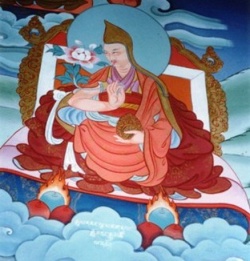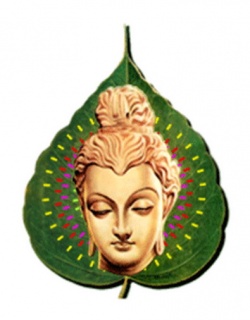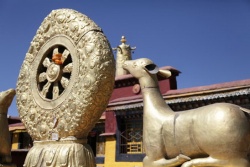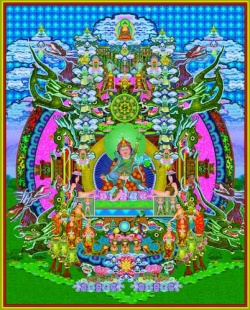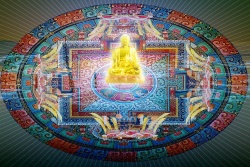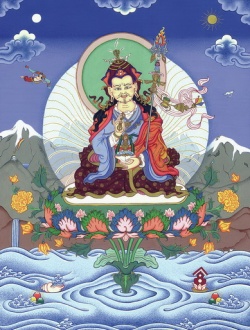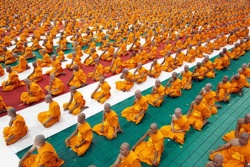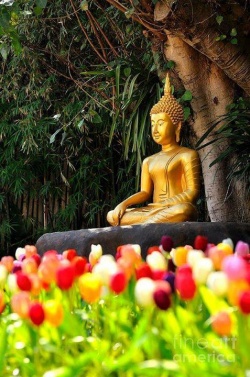5 Nikayas of Theravada Buddhism: Structure and Review I
Written by Red Zambala
Monday, 14 July 2014 13:27
Dīgha Nikāya
Collection of Long Discourses of the Buddha
This Collection in the Suttanta Pitaka, named Dīgha Nikāya as it is made up of thirty-four long discourses of the Buddha, is divided into three divisions:
(a) Sīlakkhandha Vagga, Division Concerning Morality
(b) Mahā Vagga, the Large Division
(c) Pāthika Vagga, the Division beginning with the discourse on Pāthika, the Naked Ascetic.
(a) Sīlakkhandha Vagga Pāḷi - Division Concerning Morality
This division contains thirteen suttas which deal extensively with various types of morality, namely, Minor Morality,basic morality applicable to all; Middle Morality and Major Morality which are mostly practiced by Samaṇas and Brāhmaṇas.
It also discusses the wrong views then prevalent as well as brāhmin views of sacrifice and caste, and various religious practices such as extreme self-mortification.
Dīgha Nikāya - Sīlakkhandha Vagga I
(b) Maha Vagga Pāḷi - The Large Division
The ten suttas in this division are some of the most important ones of the Tripitaka, dealing with historical, and biographical aspects as well as the doctrinal aspects of Buddhism.
The most famous sutta is the Mahāparinibbāna Sutta which gives an account of the last days and the passing away of the Buddha and the distribution of his relics.
Mahāpadāna Sutta deals with brief accounts of the last seven Buddhas and the life story of the Vipassi Buddha.
Doctrinally important are the two suttas: the Mahānidāna Sutta which explains the Chain of Cause and Effect, and the Mahāsatipaṭṭhāna Sutta dealing with the four Methods of Steadfast Mindfulness and practical aspects of Buddhist meditation.
Dīgha Nikāya - Mahā Vagga
(c) Pāthika Vagga Pāḷi
This division is made up of eleven shorter discourses of a miscellaneous nature.
They deal with the Buddhas rejection of wrong and severe asceticism practised by followers of many sects; they deal also with the periodical evolution and dissolution of the universe, the accounts of Universal Monarchs and the thirty-two physio-gnomic characteristics of a great man.
There is one discourse, Siṅgāla Sutta, addressed to a young brāhmin showing the duties to be performed by members of the human society.
The last two suttas, Saṅgīti and Dasuttara, are discourses given by the Venerable Sāriputta and they contain lists of doctrinal terms classified according to subject matter and numerical units. The style of their composition is different from the other nine suttas of the division.
Dīgha Nikāya - Pāthika Vagga III
Majjhima Nikāya
Collection of Medium Length Discourses of the Buddha.
This collection of medium length discourses is made up of one hundred and fifty-two suttas in three books known as paṇṇāsa.
The first book, Mūlapaṇṇāsa, deals with the first fifty suttas in five vaggas; the second book, Majjhimapaṇṇāsa consists of the second fifty suttas in five vaggas too;
and the last fifty-two suttas are dealt with in five vaggas of the third book, Uparipaṇṇāsa, which means more than fifty.
The suttas in this Nikāya throw much light on the social ideas and institutions of those days, and also provide general information on the economic and political life.
Mūlapaṇṇāsa
Majjhimapaṇṇāsa
Uparipaṇṇāsa
Book I Part 1 Book II Part 1 Book III Part 1
Book I Part 2 Book II Part 2 Book III Part 2-3
Book I Part 3 Book II Part 3 Book III Part 4-5
Book I Part 4-5 Book II Part 4
Book II Part 5
Saṁyutta Nikāya
This collection of discourses in the Suttanta Pitaka known as Saṁyutta Nikāya has 7762 suttas of varied length, generally short, arranged in a special order according to subject matter into five major divisions:
a) Sagāthā Vagga,
b) Nidāna Vagga,
c) Khandha Vagga,
d) Saḷāyatana Vagga and
e) Mahā Vagga.
Each major vagga is divided into fifty-six groups known as saṁyuttas — related subjects grouped together.
The saṁyuttas are named after the subjects they deal with, for example, Bojjhaṅga Saṁyutta on the Seven Factors of Enlightenment, or after some principal personalities such as the Venerable Sāriputta, King Pasenadi of Kosala, or Sakka.
Kosala Saṁyutta is a group of discourses concerning King Pasenadi of Kosala, and Devatā Saṁyutta deals with devas like Sakka, Indra, Brahma, etc.
Each Saṁyutta is further divided into sections which are made up of individual suttas.
Thus the well- known Dhammacakkappavattana Sutta is the first discourse (sutta) in the second section of Sacca Saṁyutta which comes under the Mahāvagga division of Saṁyutta Nikāya.
In the following excerpts from Saṁyutta Nikāya, only a few suttas representing each major division are given.
(a) Sagāthā Vagga Saṁyutta Pāḷi
This major division of Sagāthā Vagga Saṁyutta Pāḷi contains eleven Saṁyuttas with discourses grouped according to characters appearing in them, the king of devas, the devas, the Brahma, Mara, King of Kosala, bhikkhus and bhikkhunīs.
The name of the Vagga, Sagāthā, is derived from the fact that various personalities appearing in the discourses conducted their dialogues or interviews with the Buddha mostly in verse.
Saṁyutta Nikāya - Book I
(b) Nidāna Vagga Saṁyutta Pāḷi
This second major division of Nidāna Vagga Saṁyutta Pāḷi contains ten Saṁyuttas, all dealing, with fundamental aspects of the doctrine.
The discourses are chiefly concerned with the principles of conditionality and interdependence, explained in the detailed formula which is called “Paṭiccasamuppāda”, Conditioned Genesis or Law of Dependent Origination, consisting of twelve factors.
Various aspects of Paṭiccasamuppāda, together with expositions on doctrinal matters concerning practice of the holy life form the main theme of early suttas in these Saṁyuttas.
Saṁyutta Nikāya - Book II
(c) Khandha Vagga Saṁyutta Pāḷi
The main theme of most suttas in this division is, as the name implies, khandhas, the five aggregates that constitute what is regarded as a being.
Each of the components of these aggregates, namely: matter, sensation, perception, mental concomitants and consciousness is shown to be a bundle of dukkha, suffering.
Made up of thirteen Saṁyuttas, Khandha Vagga forms an important collection of doctrinal discussions on such topics as atta, anatta, eternity, and annihilation.
Saṁyutta Nikāya - Book III
(d) Saḷāyatana Vagga Saṁyutta Pāḷi
This division is made up of ten Saṁyuttas or groups. It deals mainly with the six sense organs or bases of contact named internal sense bases (eye, ear, nose, tongue, body and mind),
six corresponding sense objects, known as external sense bases (visible form, sound, odour, taste, tangible things and mind-objects),
and consciousness that arises in relation to each pair of these internal and external sense bases.
There are expositions on the impermanent nature of these sense bases and how relinquishing of attachment to them results in liberation.
The sensation arising from coming together of the sense bases and consciousness is shown to be of three kinds: pleasant, unpleasant, indifferent,
none of which is permanent; each one of these is the cause of craving which in turn is the root of all suffering.
Concise but illuminating expositions on Nibbāna are found in many suttas. So also are there practical guides for Vipassanā meditation.
In the very first two suttas, the Buddha explains that the six internal sense bases and six external sense bases have the nature of impermanence; being impermanent, they are really suffering and not self.
“Bhikkhus, realizing their true nature, you should not regard these twelve sense bases as “This is mine”, “This is I”, “This is my self”. Contemplate on them steadfastly, constantly, until Vipassanā Insight into their real nature arises.”
The Buddha continues to explain that insight into the true nature of the twelve Āyatanas will develop dispassion and disenchantment for them. Being disenchanted with them, there is no craving, clinging, thereby achieving the Path and Fruition.
Saṁyutta Nikāya - Book IV
(e) Mahā Vagga Saṁyutta Pāḷi
The last Vagga of Saṁyutta Nikāya is made up of twelve saṁyuttas, the list of which gives a clear indication of the subjects dealt with in this division:
Magga Samyutta, Bojjhaṅga Samyutta, Satipaṭṭhāna Samyutta, Indriya Samyutta, Sammappadhāna Samyutta, Bala Samyutta,
Iddhipāda Samyutta, Anuruddha Samyutta, Jhāna Samyutta, Ānāpāna Samyutta, Sotāpatti Saṁyutta and Sacca Samyutta.
The main doctrines which form the fundamental basis of the Buddha's Teaching are reviewed in these saṁyuttas, covering both the theoretical and practical aspects.
In the concluding suttas of the vagga, the ultimate goal of the holy life, Arahatta Phala, Nibbāna, end of all suffering, is constantly kept in full view
together with a detailed description of the way of achieving it, namely, the Four Noble Truths and the Noble Path of Eight Constituents.
In the opening suttas it is pointed out how friendship with the good and association with the virtuous is of immense help for the attainment of the Path and Perfection.
It is one of the supporting factors conducive to the welfare of a bhikkhu. Not having a virtuous friend and good adviser is a great handicap for him in his endeavours to attain the
Saṁyutta Nikāya - Book V
Aṅguttara Nikāya
This Collection of Discourses, Aṅguttara Nikāya, containing 9557 short suttas is divided into eleven divisions known as nipātas.
Each nipāta is divided again into groups called vaggas which usually contain ten suttas.
The discourses are arranged in progressive numerical order, each nipāta containing suttas with items of dhamma, beginning with one item and moving up by units of one till there are eleven items of dhamma in each sutta of the last nipāta, hence the name Aṅguttara meaning “increasing by one item”.
The first nipāta, Ekaka Nipāta, provides in each sutta single items of dhamma called the Ones; the second nipāta, Duka Nipāta, contains in each sutta two items of dhamma called the Twos,
and the last nipāta, Ekādasaka Nipāta, is made up of suttas with eleven items of dhamma in each, called the Elevens.
Aṅguttara Nikāya constitutes an important source book on Buddhist psychology and ethics, which provides an enumerated summary of all the essential features concerning the theory and practice of the Dhamma.
A unique chapter entitled Etadagga Vagga of Ekaka Nipāta enumerates the names of the foremost disciples amongst the bhikkhus, bhikkhunīs, upāsakas, upāsikās, who had achieved pre-eminence in one sphere of attainment or meritorious activity,
e.g. the Venerable Sāriputta in Intuitive Wisdom and Knowledge (Paññā); the Venerable Maha Moggallāna in supernormal powers (Iddhi);
Bhikkhunī Khema in Paññā; Bhikkhunī Uppalavaṇṇa in Iddhi; the Upāsaka Anāthapiṇḍika and the Upāsikā Visākhā in alms-giving (Dana); and so on.
Khuddaka Nikāya
Of the five Nikāyas, Khuddaka Nikāya contains the largest number of treatises (as listed below) and the most numerous categories of dhamma.
Although the word “Khuddaka” literally means "minor" or "small", the actual content of this collection can by no means be regarded as minor, including as it does the two major divisions of the Pitaka, namely, the Vinaya Pitaka and the Abhidhamma Pitaka according to one system of classification.
The miscellaneous nature of this collection, containing not only the discourses by the Buddha but compilations of brief doctrinal notes mostly in verse, accounts of personal struggles and achievements by theras and theris also in verse, the birth stories, the history of the Buddha etc., may account for its title.
The following is the list of treatises as approved by the Sixth International Buddhist Synod:
Khuddaka Nikāya:
I. Vinaya Pitaka
II. Abhidhamma Pitaka
III. Suttas not included in the first four Nikāyas:
(1) Khuddaka Pāṭha
(2) Dhammapada
(3) Udāna
(4) Itivuttaka
(5) Suttanipāta
(6) Vimānavatthu
(7) Petavatthu
(8) Theragāthā
(9) Therīgāthā
(10) Jātaka
(11) Niddesa (Mahā, Cūḷa)
(12) Paṭisaṁbhidā Magga
(13) Apadāna
(14) Buddhavaṁsa
(15) Cariyā Piṭaka
(16) Netti
(17) Peṭakopadesa
(18) Milinda Pañhā

